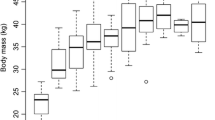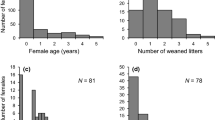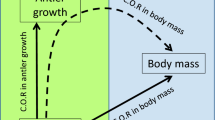Abstract
Reproductive allocation at one age is predicted to reduce the probability of surviving to the next year or to lead to a decrease in future reproduction. This prediction assumes that reproduction involves fitness costs. However, few empirical studies have assessed whether such costs may vary with the age at primiparity or might be overridden by heterogeneities in individual quality. We used data from 35 years’ monitoring of individually marked semi-domestic reindeer females to investigate fitness costs of reproduction. Using multi-state statistical models, we compared age-specific survival and reproduction among four reproductive states (never reproduced, experienced non-breeders, reproduced but did not wean offspring, and reproduced and weaned offspring) and among contrasted age at primiparity. We assessed whether reproductive costs occurred, resulting in a trade-off between current reproduction and future reproduction or survival, and whether early maturation was costly or rather reflected differences in individual quality of survival and reproduction capabilities. We did not find any evidence for fitness costs of reproduction in female reindeer. We found no cost of gestation and lactation in terms of future reproduction and survival. Conversely, successful breeders had higher survival and subsequent reproductive success than experienced non-breeders and unsuccessful breeders, independently of the age at primiparity. Moreover, it was beneficial to mature earlier, especially for females that successfully weaned their first offspring. Successful females at early primiparity remained successful throughout their life, clearly supporting the existence of marked among-female differences in quality. The weaning success peaked for multiparous females and was lower for first-time breeders, indicating a positive effect of experience on reproductive performance. Our findings emphasize an overwhelming importance of individual quality and experience to account for observed variation in survival and reproductive patterns of female reindeer that override trade-offs between current reproduction and future performance, at least in the absence of harsh winters.



Similar content being viewed by others
References
Albon SD, Mitchell B, Staines BW (1983) Fertility and body weight in female red deer: a density-dependent relationship. J Anim Ecol 52:969–980
Albon SD, Mitchell B, Huby BJ, Brown V (1986) Fertility in female red deer (Cervus elaphus): the effects of body composition, age and reproductive status. J Zool 209:447–460
Bailey RC (1992) Why we should stop trying to measure the cost of reproduction correctly. Oikos 65:349–352
Barbraud C, Weimerskirch H (2005) Environmental conditions and breeding experience affect costs of reproduction in blue petrels. Ecology 86:682–692
Beauplet G, Barbraud C, Dabin W, Kussener C, Guinet C (2006) Age-specific survival and reproductive performances in fur seals: evidence of senescence and individual quality. Oikos 112:430–441
Bérubé CH, Festa-Bianchet M, Jorgenson JT (1996) Reproductive cost of sons and daughters in Rocky Mountain bighorn sheep. Behav Ecol 7:60–68
Bize P, Roulin A, Richner H (2002) Covariation between egg size and rearing condition determine offspring quality: an experiment with the Alpine swift. Oecologia 132:231–234
Bonnet X, Naulleau G, Shine R, Lourdais O (1999) What is the appropriate time scale for measuring costs of reproduction in a capital breeder such as the aspic viper? Evol Ecol 13:485–497
Burnham KP, Anderson DR (2002) Model selection and multimodel inference: a practical information theoretic approach, 2nd edn. Springer, New York
Cam E, Link WA, Cooch EG, Monnat JY, Danchin E (2002) Individual covariation between life-history traits: seeing the trees despite the forest. Am Nat 159:96–105
Cameron MR (1994) Reproductive pause by female caribou. J Mamm 75:10–13
Choquet R, Reboulet AM, Pradel R, Gimenez O, Lebreton JD (2005a) M-SURGE 1.7 user’s manual. CEFE, Montpellier, France
Choquet R, Reboulet AM, Lebreton JD, Gimenez O, Pradel R (2005b) U-CARE 2.2 user’s manual. CEFE, Montpellier, France
Clutton-Brock TH (1984) Reproductive effort and terminal investment in iteroparous animals. Am Nat 123:212–229
Clutton-Brock TH (1991) The evolution of parental care. Princeton University Press, Oxford
Clutton-Brock TH, Guinness FE, Albon SD (1982) Red deer. Behavior and ecology of two sexes. Wildlife behavior and ecology series. The University of Chicago Press, Chicago
Clutton-Brock TH, Guinness FE, Albon SD (1983) The costs of reproduction to red deer hinds. J Anim Ecol 52:367–383
Clutton-Brock TH, Albon SD, Guinness FE (1989) Fitness costs of gestation and lactation in wild mammals. Nature 337:260–262
Clutton-Brock TH, Stevenson IR, Marrow P, MacColl AD, Houston AI, McNamara JM (1996) Population fluctuations, reproductive costs and life-history tactics in female Soay sheep. J Anim Ecol 65:675–689
Clutton-Brock TH, Illius A, Wilson K, Grenfell BT, MacColl A, Albon SD (1997) Stability and instability in ungulate populations: an empirical analysis. Am Nat 149:195–219
Cobley ND, Croxall JP, Prince PA (1998) Individual quality and reproductive performance in the grey-headed albatross Diomedea chrysostoma. Ibis 140:315–322
Cody ML (1966) A general theory of clutch size. Evolution 20:174–184
Crocker DE, Williams JD, Costa DP, Le Boeuf BJ (2001) Maternal traits and reproductive effort in northern elephant seals. Ecology 82:3541–3555
Descamps S, Boutin S, Berteaux D, Gaillard JM (2006) Best squirrels trade a long life for an early reproduction. Proc R Soc Lond Ser B 273:2369–2374
Doughty PD, Shine R (1997) Detecting life-history tradeoffs: measuring energy stores in “capital” breeders reveals costs of reproduction. Oecologia 110:508–513
Eloranta E, Nieminen M (1986) Calving of the experimental reindeer herd in Kaamanen during 1970–85. Rangifer Spec Issue 1:115–121
Festa-Bianchet M (1989) Individual differences, parasites, and the costs of reproduction for bighorn ewes (Ovis canadensis). J Anim Ecol 58:755–795
Festa-Bianchet M (1998) Condition-dependent reproductive success in bighorn ewes. Ecol Lett 1:91–94
Festa-Bianchet M, Jorgenson JT (1998) Selfish mothers: reproductive expenditure and resource availability in bighorn ewes. Behav Ecol 9:144–150
Festa-Bianchet M, Jorgenson JT, Lucherini M, Wishart WD (1995) Life-history consequences of variation in age of primiparity in bighorn ewes. Ecology 76:871–881
Festa-Bianchet M, Gaillard JM, Jorgenson JT (1998) Mass- and density-dependent reproductive success and reproductive costs in a capital breeder. Am Nat 152:367–379
Fleming IA, Lamberg A, Jonsson B (1997) Effects of early experience on the reproductive performance of Atlantic salmon. Behav Ecol 8:470–480
Forslund P, Pärt T (1995) Age and reproduction in birds—hypotheses and test. Trends Ecol Evol 10:374–378
Gaillard JM, Sempere AJ, Boutin JM, Van Laere G, Boisaubert B (1992) Effects of age and body weight on the proportion of females breeding in a population of roe deer (Capreolus capreolus). Can J Zool 70:1541–1545
Gaillard JM, Festa-Bianchet M, Yoccoz NG (1998) Population dynamics of large herbivores: variable recruitment with constant adult survival. Trends Ecol Evol 13:58–63
Gaillard JM, Festa-Bianchet M, Yoccoz NG, Loison A, Toïgo C (2000) Temporal variation in fitness components and population dynamics of large herbivores. Annu Rev Ecol Syst 31:367–393
Gaillard JM, Loison A, Festa-Bianchet M, Yoccoz NG, Solberg E (2003) Ecological correlates of life span in populations of large herbivores mammals. Pop Dev Rev (Suppl) 29:39–56
Gerhart KL, Russell DE, van de Wetering D, White RG, Cameron RG (1997) Pregnancy of adult caribou (Rangifer tarandus): evidence for lactational infertility. J Zool 242:17–30
Holand Ø, Røed KH, Mysterud A, Kumpula JM, Nieminen M, Smith ME (2003) The effect of sex ratio and male age structure on reindeer calving. J Wildl Manage 67:25–33
Holand Ø, Weladji RB, Gjøstein H, Kumpula J, Smith ME, Nieminen M, Røed KH (2004) Reproductive effort in relation to maternal social rank in reindeer (Rangifer tarandus). Behav Ecol Sociobiol 57:69–76
Holand Ø, Weladji RB, Røed KH, Gjøstein H, Kumpula J, Gaillard J-M, Smith ME, Nieminen M (2006) Male age structure influences females’ mass change during rut in a polygynous ungulate: the reindeer (Rangifer tarandus). Behav Ecol Sociobiol 59:682–688
Huber HR (1987) Natality and weaning success in relation to age of first reproduction in northern elephant seals. Can J Zool 65:1311–1316
Jonsson KI (1997) Capital and income breeding as alternative tactics of resource use in reproduction. Oikos 78:57–66
Kumpula J (2001) Winter grazing of reindeer in woodland lichen pasture: effect of lichen availability on the condition of reindeer. Small Rumin Res 39:121–130
Laaksonen T, Korpimäki E, Hakkarainen H (2002) Interactive effects of parental age and environmental variation on the breeding performance of Tengmalms owls. J Anim Ecol 71:23–31
Langvatn R, Albon SD, Burkey T, Clutton-Brock TH (1996) Climate, plant phenology and variation in age at first reproduction in a temperate herbivore. J Anim Ecol 65:653–670
Langvatn R, Mysterud A, Stenseth NC, Yoccoz NG (2004) Timing and synchrony of ovulation in red deer constrained by short northern summers. Am Nat 163:763–772
Loison A, Festa-Bianchet M, Gaillard JM, Jorgenson JT, Jullien JM (1999a) Age-specific survival in five populations of ungulates: evidence of senescence. Ecology 80:2539–2554
McNamara JM, Houston AI (1996) State-dependent life histories. Nature 380:215–221
Millar JS (1994) Senescence in a population of small mammals? Ecoscience 1:317–321
Millar JS, Derrickson EM, Sharpe STP (1992) Effects of reproduction on maternal survival and subsequent reproduction in northern Peromyscus-maniculatus. Can J Zool 70:1129–1134
Mysterud A, Yoccoz NG, Stenseth NC, Langvatn R (2001a) Effects of age, sex, and density on body weight of Norwegian red deer: evidence of density-dependent senescence. Proc R Soc Lond Ser B 268:911–919
Mysterud A, Stenseth NC, Yoccoz NG, Langvatn R, Steinheim G (2001b) Nonlinear effects of large-scale climatic variability on wild and domestic herbivores. Nature 410:1096–1099
Neuhaus P, Broussard DR, Murie JO, Dobson FS (2004) Age of primiparity and implications of early reproduction on life history in female Columbian ground squirrels. J Anim Ecol 73:36–43
Nichols JD, Kendall WL (1995) The use of multistate capture–recapture models to address questions of evolutionary ecology. J Appl Stat 22:835–846
Oftedal OT (1985) Pregnancy and lactation. In: Hudson R, White RG (eds) Bioenergetics of wild herbivores. CRC Press, Boca Raton, pp 215–238
Orell M, Belda EJ (2002) Delayed cost of reproduction and senescence in the willow tit Parus montanus. J Anim Ecol 71:55–64
Orell M, Koivula K, Rytkonen S, Lahti K (1994) To breed or not to breed: causes and implications of non-breeding habit in the willow tit Parus montanus. Oecologia 77:339–346
Orell M, Rytkonen S, Koivula K, Ronkainen M, Rahlala M (1996) Brood size manipulations within the natural range did not reveal intragenerational cost of reproduction in the Willow Tit Parus montanus. Ibis 138:630–637
Partridge L, Harvey PH (1985) Costs of reproduction. Nature 316:20
Partridge L, Harvey PH (1988) The ecological context of life-history evolution. Science 241:1449–1455
Pease CM, Bull JJ (1988) A critique of methods for measuring life history trade-offs. J Evol Biol 1:293–303
Pomeroy PP, Fedak MA, Rothery P, Anderson S (1999) Consequences of maternal size for reproductive expenditure and pupping success of grey seals at North Rona, Scotland. J Anim Ecol 68:235–253
Pradel R, Gimenez O, Lebreton JD (2005) Principles and interest of GOF tests for multistate capture-recapture models. Anim Biodivers Conserv 28:189–204
Pyle P, Nur V, Sydeman WJ, Emslie SD (1997) Cost of reproduction and the evolution of deferred breeding in the western gull. Behav Ecol 8:140–147
Reimers E (1983) Reproduction in wild reindeer in Norway. Can J Zool 61:211–217
Reimers E, Holmengen N, Mysterud A (2005) Life history variation of wild reindeer in the highly productive North Ottadalen region, Norway. J Zool 265:53–62
Reiter J, Le Boeuf BJ (1991) Life history consequences of variation in age at primiparity in northern elephant seals. Behav Ecol Sociobiol 28:153–160
Reznick D (1985) Costs of reproduction: an evaluation of the empirical evidence. Oikos 44:257–267
Robbins CT, Robbins BL (1979) Fetal and neonatal growth-patterns and maternal reproductive effort in ungulates and sub-ungulates. Am Nat 114:101–116
Robinson MR, Pilkington JG, Clutton-Brock TH, Pemberton JM, Kruuk LEB (2006) Live fast, die young: trade-offs between fitness components and sexually antagonistic selection on weaponry in Soay sheep. Evolution 60:2168–2181
Roff DA (1992) The evolution of life histories. Chapman & Hall, London
Rönnegård L, Forslund P, Danell Ö (2002) Lifetime patterns in adult female mass, reproduction and offspring mass in semidomesticated reindeer (Rangifer tarandus tarandus). Can J Zool 80:2047–2055
Sadleir RMFS (1987) Reproduction of female cervids. In: Wemmer CM (ed) Biology and management of the cervidae. Smithsonian Institution Press, Washington DC, pp 123–144
Sinervo B, DeNardo DF (1996) Costs of reproduction in the wild: path analysis of natural selection and experimental tests of causation. Evolution 50:1299–1313
Skogland T (1983) The effects of density dependent resource limitation on size of wild reindeer. Oecologia 60:156–168
Skogland T (1989) Comparative social organisation of wild reindeer in relation to food, mates and predator avoidance. Adv Ethol 29:1–74
Stearns SC (1989) Trade-offs in life-history evolution. Funct Ecol 3:259–268
Stearns SC (1992) The evolution of life histories. Oxford University Press, Oxford
Suttie JM, Webster JR (1995) Extreme seasonal growth in Arctic deer: comparisons and control mechansims. Am Zool 135:215–222
Sydeman WJ, Nur N (1994) Life history strategies of female northern elephant seals. In: Le Boeuf BJ, Laws RM (eds) Elephant seals: population ecology, behavior, and physiology. University of California Press, Berkeley, pp 121–136
Tavecchia G, Coulson T, Morgan BJT, Pemberton JM, Pilkington JC, Gulland FMD, Clutton-Brock TH (2005) Predictors of reproductive cost in female Soay sheep. J Anim Ecol 74:201–213
Testa JW (1987) Long-term reproductive patterns and sighting bias in Weddell seals (Leptonychotes weddelli). Can J Zool 65:1091–1099
van Noordwijk AJ, de Jong G (1986) Acquisition and allocation of resources: their influence on variation in life history tactics. Am Nat 128:137–142
Weladji RB, Gaillard JM, Yoccoz NG, Holand Ø, Mysterud A, Loison A, Nieminen M, Stenseth NC (2006) Good reindeer mothers live longer and become better at raising offspring. Proc R Soc Lond Ser B 273:1239–1244
Wesolowski T, Rowinski P (2006) Is there a cost of reproduction for Marsh Tits Parus palustris in a primeval forest? Ibis 148:126–132
Williams GC (1966) Adaptation and natural selection. Princeton University Press, NJ
Acknowledgements
The authors are grateful to the Finnish Game and Fisheries Research Institute and V. Tervonen and his crew at Kutuharju Reindeer Research Station for the data. Funding from the Norwegian Research Council to R. B. W. and N. G. Y., and from the Natural Sciences and Engineering Research Council of Canada to R. B. W. supported this work. The authors are also grateful to the French–Norway Network funded by CNRS and the CLIMPOP Network funded by the GICC2.
Author information
Authors and Affiliations
Corresponding author
Additional information
Communicated by Hannu Ylonen.
Rights and permissions
About this article
Cite this article
Weladji, R.B., Loison, A., Gaillard, JM. et al. Heterogeneity in individual quality overrides costs of reproduction in female reindeer. Oecologia 156, 237–247 (2008). https://doi.org/10.1007/s00442-008-0961-x
Received:
Accepted:
Published:
Issue Date:
DOI: https://doi.org/10.1007/s00442-008-0961-x




